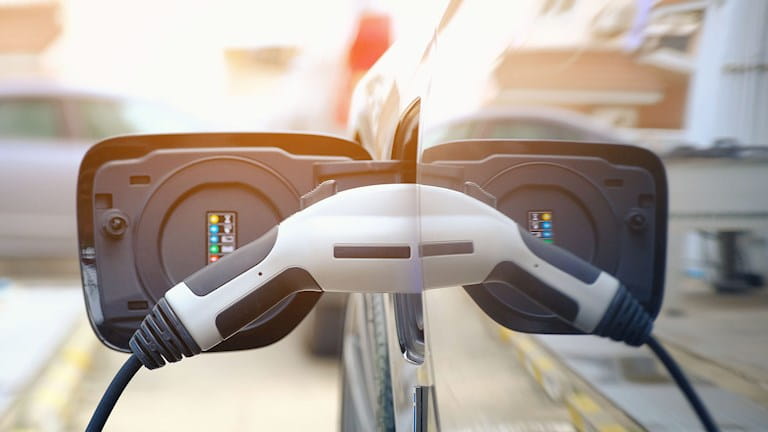National Investor-Owned Utility
Building out a new utility infrastructure for the modern age
What We Did
With increasing customer expectations and technology infrastructure approaching the end of its useful life, a national investor-owned utility needed to reevaluate its technology strategy and implement their smart grid. The utility partnered with West Monroe to:
- Upgrade its telecom network, drive operational improvements, and expand its Advanced Metering Infrastructure (AMI) infrastructure
- Streamlined and automated a previously-manual process for accepting, reviewing, and approving distributed energy resources (DERs) applications
- Assess the impact of AMI technology on the utility’s field technicians’ workflow and staffing levels, and quantify opportunities for cost savings
$8M+
in annual O&M savings after deployment
$1.5M+
in annual savings from assessment
Up to $6M
in annual labor savings
Installed new infrastructure and deployed wired and wireless technology to replace legacy connections
Aligned field operations with new AMI technology
Digitized and automated the DER interconnection application process
Part 1: A massive modernization challenge results in $8M annual savings
Project Timeline
The Challenge
When telecommunications carriers announced plans to end support for analog circuits connecting the utility’s real-time network, the utility knew it needed to modernize its grid to maintain communications and avoid unsafe operating conditions and outages.
But the utility couldn’t simply swap in a new carrier technology—an upgrade involved installing new infrastructure, maintaining engineering specifications, and powering new devices.
Faced with a daunting task, the utility worked with West Monroe to assess risk, to develop a request for funding, and to deploy the upgraded infrastructure.
The implementation began by expanding a pilot program of smart meters across a vast service territory. In addition to the smart meters, the utility evaluated its carrier services and deployed a private telecom network to address the risk of carriers ending support for critical applications. The utility partnered with West Monroe to:
- Evaluate its leased carrier inventory
- Upgrade the private network to support new devices
- Drive operational improvements through standardization and automation
- Expand its Advanced Metering Infrastructure (AMI) project
An Undeniable Approach
West Monroe began with an assessment of the business risk.
West Monroe then crafted a business argument to request funding from regulators and address legacy connections. With funding approved, the team got to work and established a project management office to provide governance and deploy the new infrastructure.
Over the next five years, West Monroe’s team led the deployment of wired and wireless technology to replace connections across the utility’s territory.
Returns You Can Measure
The utility saw returns at every phase of this project. After the initial investment and multi-year deployment, West Monroe helped save $8 million annually.
During the assessment, West Monroe uncovered $1.5 million in savings by disconnecting inactive connections – some of which had been inactive for over five years.
Overall, our team standardized technologies across several operating companies and created an effective governance process to monitor and control new connections requests.
Additional benefits of the upgraded infrastructure included:
- A digital, IP-enabled, real-time network
- Increased bandwidth and improved reliability
- Quicker response time and more flexibility than the legacy carrier networks
Part 2: Aligning field operations with new AMI technology will save $6 million annually
The Challenge
Part of this utility’s grid-modernization strategy included installing new advanced metering infrastructure (AMI) technology across its operations. This technology will pave the way for many positive benefits. But realizing those benefits requires changing the way many functions – including field services – work. This is where we excel.
West Monroe has been supporting the utility throughout the transformation, helping to build out its new infrastructure. With unique insight into the utility’s new technology and roll-out plans and expertise in productivity improvement, our team helped the utility address and answer key questions: What level of annual labor cost savings can it expect by implementing new technology? What improvements should it make as it rolls out new technology? What is the right future staffing level based on expected demand for field services?
The Opportunity
Introducing new technology will change the way that field technicians perform various activities by reducing the need for paperwork and manual data entry. Maximizing its return on investment in new technology requires empowering the utility’s field technicians to do their jobs efficiently. In order to do so, the utility had to:- Understand what needs to change and quantify the impact of those changes on field technician activities
- Define new workforce processes
- Define staffing levels to meet forecasted workload and customer demand
An Undeniably Different Approach
Our team came to the table with a distinctive approach – one steeped both the art and the science of workforce optimization and productivity improvement. We didn’t just estimate the workforce impact of new technology. We measured current and future tasks in order to deliver a more precise and realistic savings target.
We worked with the utility’s project sponsors and field operations subject matter experts tailor our approach to the utility’s unique operations and its AMI smart meter implementation plans. Our team:
- Documented workflows, task-level details, categories of activities performed, estimated task duration, and potential barriers to task success
- Mapped 11 unique field technician processes and observed field technicians completing tasks to identify areas for improvement
- Measured the work content of 20 field technician job types changed by the new technology and quantified the both the impact of changes to those tasks as well as potential sav
- Developed an activity-based model that reflects workforce resource requirements based on forecasted workload
Project Timeline
Returns You Can Measure
Our study gave the utility a vital piece of insight before it purchases and implements the new technology: Through the adoption of new technologies and quick-win process changes, it validated that the utility could realize a reduction of up to 12% in required labor hours, resulting in savings of more than $6 million annually.
The utility now has a realistic future staffing model designed around projected demand for field service. Based on our calculations, the utility could realize an additional $4-6 million in annual labor savings through other initiatives such as right-sizing its workforce.
Part 3: Our proprietary automation platform cuts DER application approval time in half
What We Did
As the number of applications to install distributed energy resources (DERs) skyrocketed, the utility’s manual processes for accepting, reviewing, and approving DER applications increasingly burdened its staff – inhibiting both productivity and customer experience.
That’s where we stepped in. Our team not only streamlined and automated key interconnection activities such as payment processing, payment receipts, document creation, and engineering review calculations. Because we were able to leverage our existing and proven platform for managing DER application workflows, our solution also delivered tangible improvements rapidly.
50%
faster application approval
300%
greater application processing throughput
$4 million
revenue generated through electronic payments
The Opportunity
Distributed energy resources such as rooftop solar, community solar, electric vehicle (EV) charging stations, and battery storage systems are growing rapidly. Connecting a DER asset with the electric grid – a process known as interconnection – requires the utility’s review and approval.
As application volume rose sharply, the utility’s interconnections team found itself bogged down with labor-intensive, paper-based activities required to process DER-related payments, communicate between departments during review, and access or enter data in multiple utility systems. Imagine a representative placing a customer on hold while locating the paper application in a filing cabinet in order to respond to that customer’s inquiry.
With the application volume only expected to grow, the utility needed to:
- Automate selected interconnection processes
- Boost staff productivity in order to keep up with increasing demand
- Improve the application experience for employees, customers, and contractors such as solar developers
- Free staff to focus on value-added activity
An Undeniably Different Approach
West Monroe brought a solution powered by Intellio Connect®, our proprietary cloud-based digital platform designed to provide workflow management for DER application approvals. Armed with an asset that is already well established and continuously updated to reflect the current DER marketplace, our team could accelerate the transition to automated DER application processes – allowing the utility to realize benefits faster.
We worked with the utility to:
- Determine which activities to automate using existing Intellio Connect® capabilities
- Redesign and streamline processes to improve transparency for customers and contractors
- Implement automation and prepare system users
The other undeniably different aspect of our approach is our emphasis on data-driven management. Leveraging the tool’s reporting capabilities, we worked with the utility’s team to establish and deliver relevant process metrics and insights – facilitating better operations, communication, and decision making.
Returns You Can Measure
There are many ways to measure impact, but one efficiency and experience metric stands out: elapsed time between application submission and approval. By automating targeted activities, the utility now processes twice as many applications in half the time, while interconnection processing throughput has increased by 300%.
The solution has also created a better experience for everyone involved:
- Contractors can submit applications online, pay electronically, upload documents, and chat in real time with interconnection staff.
- Customers receive proactive communication about the status of their applications and notices when actions are required.
- Interconnection and engineering staff can now focus on value-added activities, with the minutia now automated.
- Interconnection managers gained the data they need to communicate with executives and regulatory agencies, as well as their own teams about application progress, work assignments, and team performance.
In fact, the utility considers access to data to be one of the most crucial outcomes of this project – and a core aspect of its ability to run interconnection operations successfully.
Part 4: Creating a Market-Leading Approach for Serving Limited-Income Customers
What We Did
Designed a market-leading program for supporting limited-income customers in communities of greatest need.
The Opportunity
The utility wants to be a leader and innovator in supporting limited-income customers. To accomplish this goal, it needs to improve its programs for this segment—offering a combination of energy affordability, economic opportunity, and equitable access to clean technologies.
This project did not start because of the pandemic, but the events of 2020 cast an unexpected focal point on limited-income programs. Due to pandemic-related shutdowns, the utility saw a sharp increase in its eligible customer base for limited-income assistance. At the same time, the utility’s partner for enrolling customers in limited-income utility assistance programs had to close its in-person services and did not have options for assisting customers remotely during the pandemic.
That’s when the utility called West Monroe.
An Undeniably Different Approach
Traditionally, people think of programs for limited-income customers as involving financial or similar incentives. While this is certainly an important facet of low-income assistance, we believe this doesn’t solve the broader challenge because it is narrowly focused and doesn’t target assistance for communities of greatest need. So, we brought an undeniably different approach.
First, we recognize the importance of cross-functional collaboration to solve challenges. That principle is how we work and bring unique perspectives to our clients. We engaged utility stakeholders from across business functions to develop the program together—enabling a focus not just on financial assistance but also energy efficiency and economic development programs relevant to limited-income customers.
Additionally, we used empirical analysis to create a “communities in need (CIN)” model. By combining the Economic Hardship Index method with census data at the zip code level, we produced a CIN index to measure economic conditions of communities within the utility’s service territory. Based on our preliminary modeling, we could pinpoint certain city neighborhoods, as well as other potential areas in the county and surrounding counties, that should receive investment.
Outcomes
- Analyzed the energy burden of customers – the percentage of household income allocated to energy costs – and determined the subsets of low-income customers most in need of support and investment
- Quantified the required funding increase
- Established energy burden reduction goals for these customer groups
- Identified customers and communities that will benefit most from assistance
- Developed new programs to reduce the gap between current support provided and customers’ support needs – leveraging best practices from utility benchmarking
- Identified opportunities in the customer enrollment process and developed a 9-step solution to increase enrollment by 200% in 5-years
Returns You Can Measure
The utility now has a comprehensive, long-term strategy for lifting up communities of need through a combination of energy affordability, equitable access to new technologies, and workforce development. Importantly, it also has executive-level support across the organization to move that strategy forward. The detailed action plan will guide the utility toward meeting its commitment to double the number of limited-income customers assisted and the amount of funding available for financial assistance programs – thus maximizing the program’s reach and its impact in areas of greatest need.
Furthermore, the research we conducted as part of the project guided a landmark state commerce commission approval of COVID-19 utility relief for vulnerable customers.




.png?mw=400&mh=100&iar=0&as=1&hash=E92F955389AF8D0D1713453E8F092403)









.png?mw=400&mh=100&iar=0&as=1&hash=C61648826932876E29BEB8C11B66F69E)